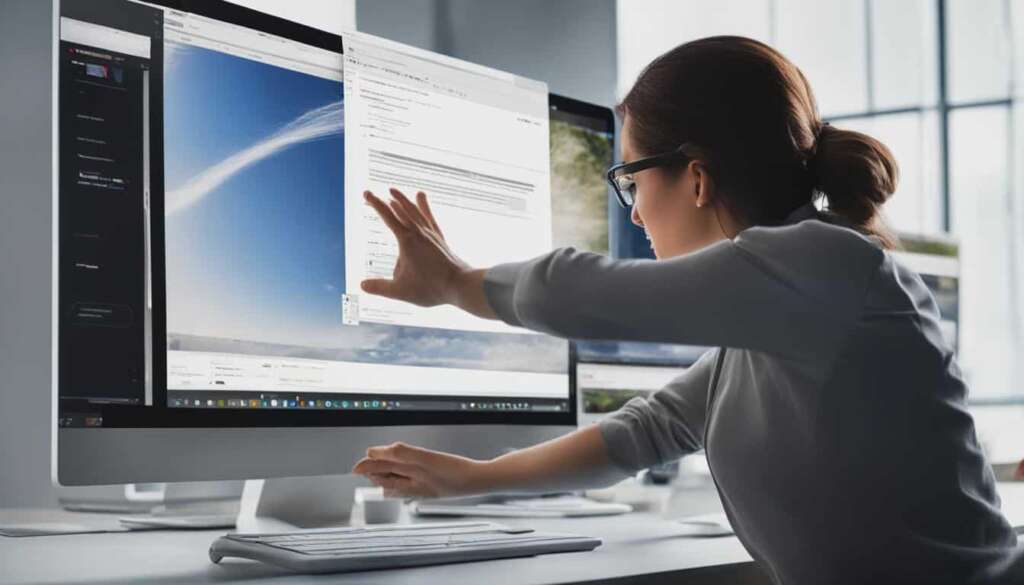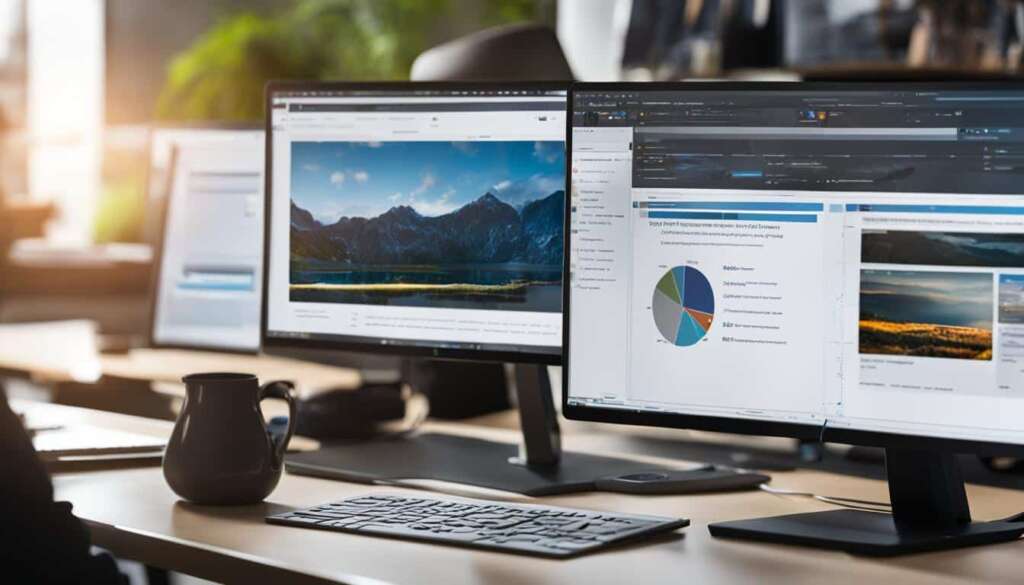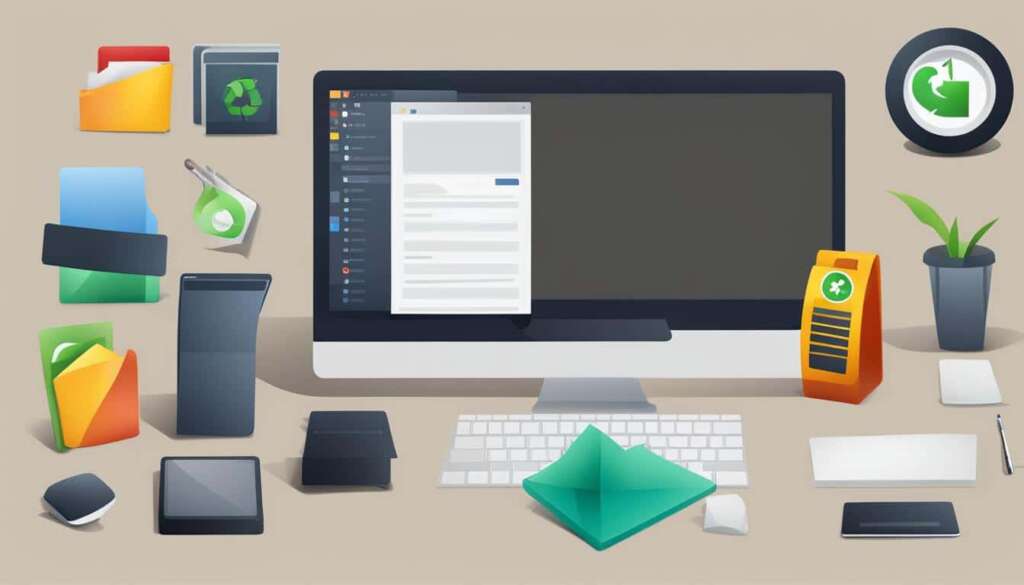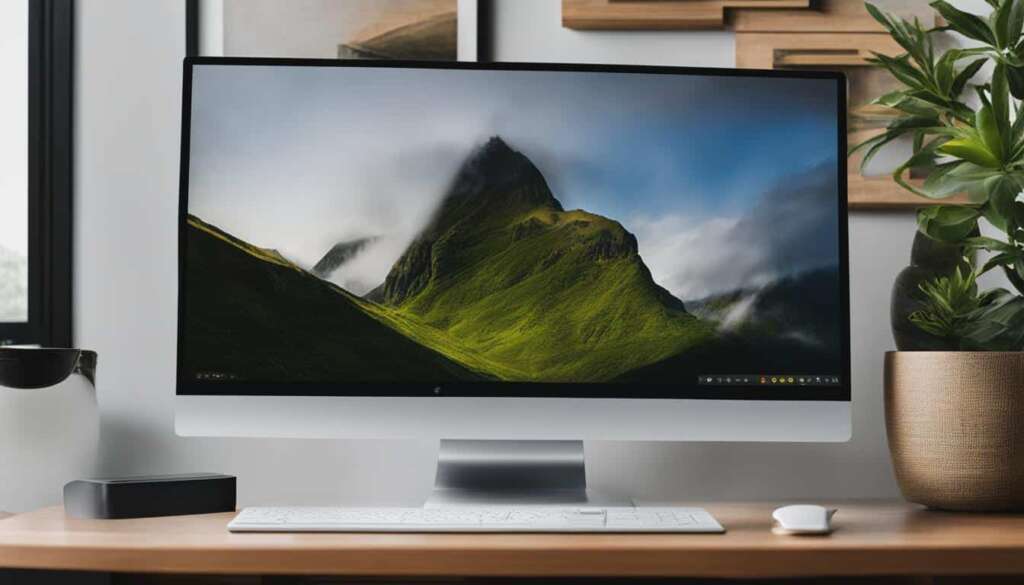Table of Contents
In today’s digital age, where efficiency and aesthetics go hand in hand, it’s essential to optimize every aspect of our digital workspace. One simple way to achieve a sleeker look on your desktop is by making your icons smaller. By reducing the icon size, you not only create a more refined visual experience, but you also enhance the clarity of your screen. In this article, we’ll explore how to make icons smaller on your desktop and provide you with step-by-step instructions to resize desktop icons.
So, how do you make icons smaller on your desktop? It’s easier than you might think. By following a few simple steps, you’ll be able to decrease the icon size and transform your desktop into a more streamlined and organized workspace. Whether you’re looking to maximize your screen real estate or simply prefer a more compact display, resizing desktop icons is the key to achieving your desired aesthetic.
To begin, right-click anywhere on your desktop and select “View” from the context menu. From there, you’ll find an option to change the icon size. By selecting a smaller size, you’ll instantly see the difference as your icons shrink to fit your preference. This not only allows you to fit more icons on your desktop, but it also provides a clearer view of your wallpaper or background image.
Furthermore, if you have a mouse with a scroll wheel, you can even take it a step further. Hold down the CTRL key on your keyboard and scroll up or down using the scroll wheel. This allows you to easily resize the icons in real-time, giving you the flexibility to find the perfect balance between functionality and aesthetics.
By decreasing the size of your desktop icons, you’ll not only optimize your workspace but also create a more visually appealing and personalized digital environment. So why wait? Start resizing your desktop icons today and experience the transformation for yourself. Follow our step-by-step guide and unlock the full potential of your digital workspace.
Stay tuned for more tips and tricks on how to enhance your Windows experience and create a workspace that truly reflects your style and productivity needs.
Turn on Dark Mode in Windows 10
Windows 10 offers a dark mode option that can transform the appearance of many programs and alleviate eye strain. Dark mode provides a visually appealing, high-contrast interface that is easy on the eyes, particularly in low-light settings. By making use of dark mode, you can enhance your overall user experience on your Windows 10 device.
To turn on dark mode, follow these simple steps:
- Click the Start button located in the bottom left corner of the screen.
- Next, click the Settings icon, which resembles a gear wheel.
- In the Settings menu, locate and click on the “Personalization” option.
- Within the “Personalization” menu, find and select “Colors”.
- Under the “Choose your default Windows mode” setting, enable the “Dark” option to activate dark mode throughout your Windows interface.
- Additionally, under the “Choose your default app mode” setting, select the “Dark” option to ensure that any compatible apps also switch to dark mode.
It is worth noting that certain programs, such as the Microsoft Office suite, might possess individual dark mode settings that can be accessed through their respective settings menus. To enable dark mode in such applications, navigate to the program’s settings menu and look for the dark mode switch.
Darker interface, reduced eye strain, better focus
Dark mode in Windows 10 provides a multitude of benefits, including:
- Reduced eye strain: The dark interface reduces the intensity of bright light emitted from your screen, which can cause eye fatigue and strain over extended periods of time.
- Better focus: The high-contrast dark mode interface helps to eliminate distractions, allowing you to focus more effectively on your tasks or content.
- Enhanced readability: Dark mode’s light text on a dark background can improve text legibility, making it easier to read and comprehend.
Whether you’re working late at night, in a dimly lit environment, or simply prefer the sleek aesthetics of dark mode, enabling this feature in Windows 10 can vastly improve your visual comfort and overall user experience.
Adjust the Size of Desktop Icons
If you find that the desktop icons are too large, you can easily adjust their size to your preference. Simply right-click anywhere on the desktop, click on “View,” and choose the desired icon size.
You can select small icons to fit more on the desktop and have a better view of your wallpaper. Additionally, if you have a mouse with a scroll wheel, you can hold down the CTRL key and scroll to resize the icons.
“Customizing the size of desktop icons allows you to create a more personalized and organized digital workspace.”
By adjusting the size of the desktop icons, you can optimize your workspace and enhance the overall aesthetic of your desktop. Whether you prefer smaller icons for a sleeker look or larger icons for improved visibility, Windows provides you with the flexibility to customize the icon size to your liking.
Smaller icons can be particularly beneficial if you like to have a clutter-free desktop, as they allow you to fit more icons on the screen without sacrificing functionality. This can be especially useful for users who frequently access various files and applications directly from their desktop.
On the other hand, larger icons can make it easier to locate specific files or applications at a glance, especially for users with visual impairments or those who prefer a more prominent display.
Regardless of your preference, resizing desktop icons in Windows is a quick and straightforward process that empowers you to create a desktop layout that aligns with your workflow and aesthetic preferences.
| Icon Size | Benefits |
|---|---|
| Small | – Fit more icons on the desktop – Enhanced view of wallpaper |
| Large | – Easier identification of files and applications – Improved visibility |
Customize Taskbar Size in Windows 10
Maximizing your screen real estate and creating a tidier desktop layout can greatly improve your productivity and overall user experience. One effective way to achieve this is by customizing the size of the taskbar in Windows 10.
To begin, simply follow these steps:
- Right-click on an empty space in the taskbar.
- Select “Properties” from the context menu that appears.
- In the “Taskbar” tab of the “Taskbar and Start Menu Properties” window, check the “Use small icons” box.
By enabling the “Use small icons” option, you can effectively reduce the size of the taskbar buttons. This not only creates a more streamlined look but also allows for more screen real estate to work with.
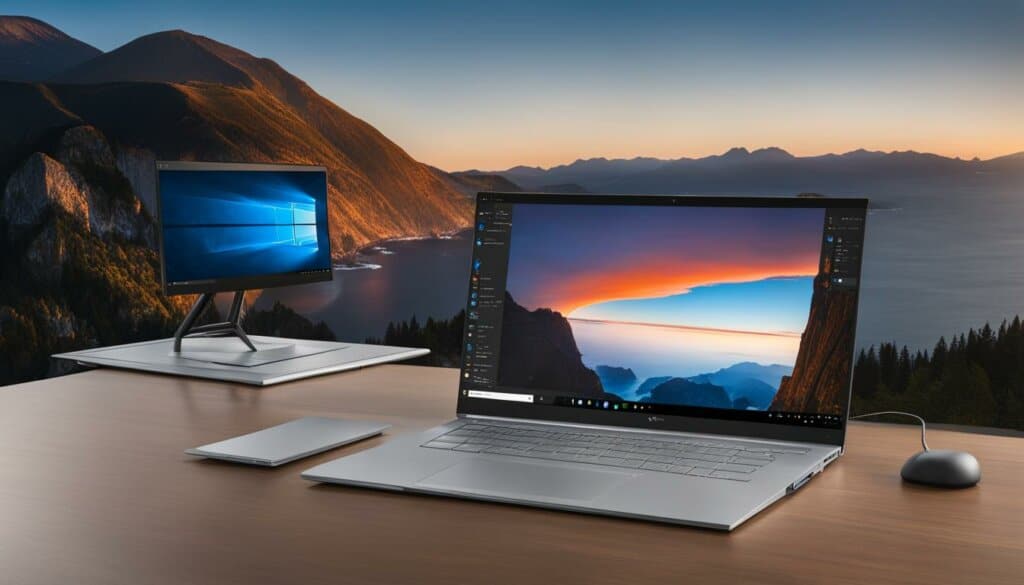
With smaller taskbar buttons, you can focus on the tasks at hand without distractions. Whether you’re a professional working on multiple projects or a student organizing your study materials, a customized taskbar size can enhance your workflow and desktop aesthetics.
Enable Dark Mode in Specific Windows Apps
While enabling dark mode at the system level in Windows 10 will apply it to many apps, some specific apps may have their own independent dark mode settings. For example, in Microsoft Office apps like Word, Excel, or Outlook, you can access dark mode settings by clicking on “File,” then “Options,” and selecting a dark theme such as “Dark Gray” or “Black.” By enabling dark mode in these apps, you can create a consistent visual experience and reduce eye strain.
Dark mode in Windows apps enhances the look and feel of your digital workspace while reducing the strain on your eyes. It provides a sleek and modern aesthetic that is easier on the eyes, especially in low-light environments. With dark mode, you can work comfortably for longer periods, focusing on your tasks without unnecessary distractions.
Embrace the power of dark mode settings in Microsoft Office and other Windows apps to transform your digital experience into a visually captivating and soothing environment.
Enabling dark mode in specific Windows apps offers a cohesive and unified appearance, creating a seamless user experience across your favorite productivity tools. Whether you’re crafting a document in Word, analyzing data in Excel, or managing your emails in Outlook, dark mode settings enhance the overall usability and aesthetics of these apps.
In addition to the functional benefits, dark mode also adds a touch of elegance and style to your digital workflow. The dark background and contrasting colors make content pop, ensuring better readability and focusing attention on the most crucial elements of your work.
To enable dark mode in Microsoft Office apps and other Windows apps, follow these simple steps:
- Open the desired app (e.g., Microsoft Word, Excel, Outlook).
- Click on “File,” typically located in the top-left corner of the app.
- Choose “Options” from the drop-down menu. This will open the app’s settings.
- Navigate to the “General” or “Personalization” section, depending on the app.
- Look for the dark mode or theme option and select “Dark Gray” or “Black” from the available choices.
- Save your changes and enjoy the transformed look of the app with dark mode enabled.
By enabling dark mode in Windows apps, you can immerse yourself in a visually appealing and comfortable working environment. Dark mode not only enhances your productivity but also showcases your style and preference for a modern digital workspace.
Additional Customization Options for Windows 10
Windows 10 offers a range of customization options beyond resizing icons and enabling dark mode. These additional features allow you to personalize your Windows experience according to your needs and preferences.
Empty Recycle Bin in Windows 10
To empty the recycle bin in Windows 10, simply right-click on the recycle bin icon on your desktop and select “Empty Recycle Bin” from the dropdown menu. This action permanently deletes all files and folders currently residing in the recycle bin, freeing up valuable storage space on your computer.
Create a Guest Account in Windows 10
Creating a guest account in Windows 10 is a convenient way to provide temporary access to your computer without compromising your personal settings and files. To create a guest account, follow these steps:
- Click on the Start button and open the settings menu.
- Go to the “Accounts” section and select “Family & other users”.
- Click on “Add someone else to this PC” under the “Other users” section.
- Follow the prompts to create a new account and set it as a guest account.
Find Screenshots in Windows 10
Windows 10 allows you to easily locate the screenshots you have captured. By default, screenshots are saved in the “Pictures” folder. To find your screenshots, follow these steps:
- Open the File Explorer by clicking on the folder icon in the taskbar.
- Navigate to the “Pictures” folder.
- Look for a subfolder named “Screenshots”. All your captured screenshots will be stored in this folder.
Copy Your Screen in Windows 10
In Windows 10, you can easily copy the contents of your screen to share or save for future reference. To copy your screen, commonly known as taking a screenshot, use the “Print Screen” key on your keyboard. It is usually located in the top-right corner. Once pressed, the screenshot will be placed on your clipboard. You can then paste it into an image editing software or document to view or manipulate the captured image.

Conclusion
By following the steps outlined in this article, you can easily optimize your desktop icons, customize the taskbar, and personalize your Windows experience. These simple tweaks will help you create a sleeker, more organized, and tailored digital workspace.
Resizing the desktop icons allows you to enhance clarity and create a refined look. Adjusting the size of the icons can be done by right-clicking on the desktop, selecting “View,” and choosing the desired icon size. Additionally, holding down the CTRL key and scrolling with a mouse’s scroll wheel can also resize the icons.
Customizing the size of the taskbar is another way to optimize your Windows experience. By right-clicking on the taskbar, selecting “Properties,” and checking the “Use small icons” box, you can reduce the size of the taskbar buttons. This maximizes your screen real estate and promotes a tidier desktop layout.
Furthermore, enabling dark mode in specific Windows apps, such as Microsoft Office, can provide a consistent visual experience and reduce eye strain. Accessing dark mode settings in these apps can usually be done through their respective menus, allowing you to work seamlessly in a dark-themed interface.
By exploring the various customization options available in Windows 10, you can optimize your desktop icons and create a personalized Windows experience that caters to your needs and preferences. Take advantage of these simple yet impactful adjustments to enhance your digital workspace and make the most out of your Windows device.
FAQ
How do I make icons smaller on my desktop?
To make icons smaller on your desktop, simply right-click anywhere on the desktop, click on “View,” and choose the desired icon size. You can also hold down the CTRL key and scroll with your mouse wheel to resize the icons.
How do I turn on dark mode in Windows 10?
To turn on dark mode in Windows 10, click the Start button, then click the Settings icon. Navigate to the “Personalization” menu, select “Colors,” and enable the “Dark” option under both the “Choose your default Windows mode” and “Choose your default app mode” settings. Some apps, like Microsoft Office, may have their own dark mode switch in their settings menu.
Can I adjust the size of the taskbar in Windows 10?
Yes, you can adjust the size of the taskbar in Windows 10. Simply right-click on an empty space in the taskbar and select “Properties.” In the Taskbar tab, check the “Use small icons” box to reduce the size of the taskbar buttons.
How do I enable dark mode in specific Windows apps?
Some Windows apps, like Microsoft Office, have their own dark mode settings. To enable dark mode in these apps, open the app and click on “File,” then “Options.” Look for a dark theme option, such as “Dark Gray” or “Black,” and select it to enable dark mode.
Are there additional customization options for Windows 10?
Yes, Windows 10 offers additional customization options. You can learn how to empty the recycle bin, create a guest account, find screenshots, and copy your screen for various purposes. These options allow you to personalize your Windows experience according to your needs and preferences.

